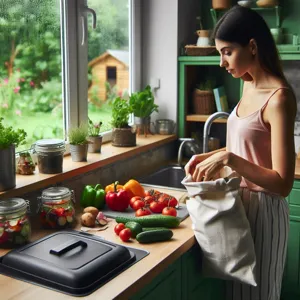In a world increasingly aware of the environmental impact of our daily choices, the kitchen presents a unique opportunity to make a difference.
Cooking sustainably not only benefits the planet but also encourages healthier eating habits and fosters a deeper appreciation for the ingredients we use. With climate change and resource depletion becoming more pressing issues, it’s essential to rethink how we prepare our meals. This blog post will guide you through 10 simple steps that can transform your cooking practices into eco-friendly habits. From selecting local and seasonal produce to minimizing food waste and exploring plant-based alternatives, these actionable tips will empower you to reduce your carbon footprint while enjoying delicious meals. Join us on this journey toward a more sustainable kitchen, where every bite counts in the fight for a healthier planet!
1. Understanding Sustainable Cooking: What It Means

Understanding sustainable cooking is the cornerstone of reducing your carbon footprint and making more environmentally conscious choices in the kitchen. At its core, sustainable cooking involves selecting ingredients and preparing meals in a way that minimizes harm to the planet while promoting health and well-being for both consumers and the environment. It’s about more than just choosing organic produce; it encompasses a holistic approach to food sourcing, preparation, and consumption.
Sustainable cooking begins with an awareness of where your food comes from. This means prioritizing local and seasonal ingredients, which not only supports local farmers and economies but also reduces the carbon emissions associated with transporting food over long distances. When you choose to shop at farmers’ markets or join a community-supported agriculture (CSA) program, you’re not just getting fresher produce; you’re also fostering a connection to your food and its origins.
Additionally, sustainable cooking promotes the idea of reducing waste. This can be achieved by utilizing every part of the ingredient—think of beet greens or broccoli stems that might otherwise be discarded. Creative meal planning and proper food storage techniques can help minimize leftovers and prevent food spoilage, ultimately reducing the amount of food that ends up in landfills.
Another vital aspect is being mindful of the cooking methods you use. Opting for energy-efficient appliances or cooking in batches can drastically cut down on energy consumption. Conscious choices, such as using pots and pans that retain heat well or turning off the oven a few minutes early, can lead to significant carbon savings over time.
In essence, understanding sustainable cooking is about integrating these principles into your daily routine. It encourages a shift in mindset from convenience and consumption to one of mindfulness and responsibility. By embracing sustainable cooking practices, you can not only enjoy delicious meals but also contribute to a healthier planet for future generations.
2. Step 1: Choose Local and Seasonal Ingredients
Choosing local and seasonal ingredients is one of the most impactful steps you can take toward cooking sustainably. When you source your produce, meats, and dairy from local farms, you not only support your community but also significantly reduce the carbon footprint associated with transporting food over long distances. Seasonal ingredients are typically fresher, tastier, and packed with nutrients, as they are harvested at their peak ripeness.
Imagine biting into a ripe tomato in the peak of summer; its flavor bursts with the essence of the sun and soil that nurtured it. In contrast, a tomato shipped from thousands of miles away may lack the same vitality and taste. By choosing local, you also encourage biodiversity and help maintain the unique agricultural practices of your region.
Visit your local farmers’ market or join a community-supported agriculture (CSA) program to discover what’s in season and available near you. Seasonal produce often includes a variety of fruits and vegetables that you may not usually consider, inspiring creativity in your cooking. Whether it’s vibrant squash in the fall, lush greens in the spring, or juicy berries in the summer, each season offers a bounty of flavors that can elevate your meals while being mindful of the environment.
By making a conscious effort to select local and seasonal ingredients, you’re not just feeding your family; you’re fostering a more sustainable food system that benefits the planet and supports local economies. This simple yet profound step can help set the foundation for a more eco-friendly kitchen, and as you explore the rich flavors of seasonal produce, you may just find that your meals become more satisfying and delicious than ever before.
3. Step 2: Incorporate More Plant-Based Meals

Incorporating more plant-based meals into your diet is not only a delicious way to diversify your culinary repertoire, but it’s also one of the most impactful steps you can take to reduce your carbon footprint. The production of plant-based foods generally requires fewer natural resources and emits fewer greenhouse gases compared to the production of animal-based products. By swapping even a few meals a week for plant-based options, you can significantly lessen your environmental impact.
Start by exploring the vibrant world of fruits, vegetables, legumes, grains, nuts, and seeds. These ingredients are not only packed with nutrients but also offer a multitude of flavors and textures that can make every meal exciting. Consider planning meatless Mondays or experimenting with “veganizing” your favorite recipes. For instance, replace ground beef with lentils or chickpeas in tacos, or use cauliflower as a base for a hearty pizza crust.
Don’t be afraid to try new ingredients and cuisines! Dive into the rich traditions of plant-based cooking from around the world—Indian dals, Mediterranean tabbouleh, or Thai curries can easily become staples in your kitchen. Additionally, focus on seasonal and local produce to further enhance the sustainability of your meals. This not only cuts down on the carbon emissions associated with transporting food long distances but also supports local farmers and encourages biodiversity.
As you explore plant-based cuisine, you may find that it fosters a deeper connection with your food. Engaging with the colors, aromas, and flavors of fresh ingredients can transform the way you cook and eat. By making this shift, you’re not just feeding yourself; you’re also contributing to a healthier planet. So grab your apron and get ready to create delicious, sustainable meals that everyone can enjoy!
4. Step 3: Reduce Food Waste: Tips for Better Planning
Reducing food waste is a pivotal step in cooking more sustainably and minimizing your carbon footprint. Not only does it help save resources and energy, but it also encourages better meal planning and thoughtful consumption. Here are some practical tips to get you started on your journey toward reducing waste in your kitchen.
Firstly, take a moment to assess what you already have in your pantry and refrigerator before making a grocery list. Understanding your existing inventory can help you avoid purchasing duplicate items and using up ingredients that might otherwise go bad. Create a meal plan based on what you have, incorporating these ingredients into your dishes throughout the week. This not only cuts down on waste but also inspires creativity in the kitchen as you experiment with different recipes.
Another effective strategy is to embrace “first in, first out” (FIFO) practices. When you bring new groceries home, place them behind older items in your pantry and refrigerator. This simple organizational tip encourages you to use older products first, ensuring that they don’t spoil before you have a chance to enjoy them.
Consider repurposing leftovers as well. Instead of letting yesterday’s meal languish in the fridge, think of inventive ways to transform it into something new. For instance, roasted vegetables can be tossed into a hearty soup, or last night’s grilled chicken can serve as a tasty filling for wraps or salads. Not only does this reduce waste, but it also saves you time and effort in preparing new meals.
Lastly, familiarize yourself with proper storage techniques to extend the shelf life of your produce. Certain fruits and vegetables thrive in specific environments; for example, keep apples in the fridge to maintain their crispness, while bananas do better at room temperature. Investing in good-quality storage containers can also help keep your food fresh longer and reduce spoilage.
By implementing these strategies, you can significantly reduce food waste in your kitchen, contributing to a more sustainable cooking routine. Remember, every small effort counts in the quest to lower our carbon footprint and promote a healthier planet.
5. Step 4: Embrace Whole Foods Over Processed Foods

When it comes to cooking sustainably, one of the most impactful changes you can make is to embrace whole foods over processed foods. Whole foods are those that are in their natural state or have undergone minimal processing, such as fresh fruits, vegetables, whole grains, legumes, nuts, and seeds. These foods not only provide essential nutrients but also come with a lower environmental footprint compared to their heavily processed counterparts.
Processed foods often require significant amounts of energy, water, and resources to produce, package, and transport. The manufacturing processes can generate substantial greenhouse gas emissions, which contribute to climate change. Moreover, these foods are frequently wrapped in layers of plastic and other materials that exacerbate waste issues. By choosing whole foods, you’re not only making healthier dietary choices but also reducing the demand for these environmentally taxing products.
Incorporating more whole foods into your meals can be both a delicious and rewarding experience. Picture this: a vibrant salad bursting with colorful, seasonal vegetables, a hearty grain bowl featuring brown rice or quinoa topped with roasted chickpeas, or a comforting vegetable stew simmered with aromatic herbs. These dishes showcase the flavors and textures of nature, allowing you to enjoy a rainbow of nutrients while minimizing your impact on the planet.
Additionally, shopping for whole foods often means supporting local farmers and markets, which can help reduce the carbon footprint associated with transportation. As you fill your cart with fresh produce, you’re not just investing in your health, but also contributing to a more sustainable food system. So, next time you’re planning your meals, consider reaching for whole foods and savor the satisfaction of cooking with ingredients that are both good for you and the planet.
6. Step 5: Learn to Preserve and Ferment Foods
Learning to preserve and ferment foods is not only a delicious way to reduce waste and extend the shelf life of your produce, but it also promotes a sustainable kitchen environment. By harnessing the art of preservation, you can enjoy seasonal ingredients year-round while minimizing your carbon footprint.
Preserving foods through methods like canning, pickling, and freezing allows you to take full advantage of fresh produce during its peak season. For example, when tomatoes are at their juiciest and most flavorful, can a batch of homemade salsa or sauce. This not only reduces reliance on store-bought products that may have traveled long distances but also cuts down on plastic waste from packaging.
Fermentation, on the other hand, is an ancient technique that transforms food into tangy, probiotic-rich delights while also enhancing flavors. Think of crunchy kimchi, zesty sauerkraut, or creamy yogurt. These foods not only add diversity to your meals but also contribute to a more resilient gut microbiome, making them a healthful addition to your diet.
Both preservation and fermentation are also fantastic ways to engage with your food. The process teaches you about seasonal cycles, the importance of local sourcing, and the joy of creating something from scratch. Plus, you’ll find that the final products often taste better than their store-bought counterparts, with a freshness and vibrancy that truly shine.
By embracing these techniques, you not only reduce food waste but also cultivate a deeper connection with your ingredients. So roll up your sleeves, dive into some jars, and start experimenting with flavors. Your taste buds—and the planet—will thank you!
7. Step 6: Use Energy-Efficient Cooking Methods

When it comes to cooking sustainably, one of the most impactful steps you can take is to adopt energy-efficient cooking methods. Not only do these techniques help minimize your carbon footprint, but they also save you money and time in the long run.
First, consider the appliances you use. Switching from traditional ovens to convection ovens can make a significant difference. Convection ovens circulate hot air, cooking food more evenly and quickly, which means you can lower the temperature and reduce energy consumption. Similarly, using induction cooktops, which heat pots and pans directly through magnetic fields, is not only faster but also more energy-efficient compared to gas or electric stovetops.
Next, embrace the art of batch cooking. Preparing multiple meals at once not only saves energy by using the oven or stove for extended periods but also minimizes food waste, a significant contributor to carbon emissions. Additionally, consider utilizing a slow cooker or pressure cooker. These appliances are designed to cook food thoroughly while consuming far less energy than conventional methods, with the added benefit of enhancing the flavors of your dishes.
Don’t forget about the power of simmering and steaming. Using these methods instead of boiling food can significantly reduce energy use, as they require less water and heat to achieve the desired results. Plus, steaming vegetables helps retain their nutrients, making your meals healthier.
Finally, always remember to use lids on pots and pans. This simple action traps heat and moisture, allowing food to cook faster and at lower temperatures. By being mindful of the cooking methods you choose, you can enjoy delicious meals while making a positive impact on the environment. Cooking sustainably is not just about the ingredients; it’s about how you prepare them too!
8. Step 7: Opt for Sustainable Seafood and Meat
When it comes to sustainable cooking, choosing the right proteins can make a significant impact on your carbon footprint and the health of our oceans and ecosystems. Opting for sustainable seafood and meat not only supports ethical farming and fishing practices but also helps preserve the delicate balance of our environment.
Sustainable seafood is sourced from fisheries that maintain fish populations and minimize environmental damage. Look for labels and certifications that indicate responsible practices, such as the Marine Stewardship Council (MSC) and the Aquaculture Stewardship Council (ASC). These organizations ensure that the seafood you choose has been harvested in a way that supports long-term ecological balance. By selecting fish like wild-caught salmon or sustainably farmed shrimp, you can enjoy your meals while contributing to the health of our oceans.
Similarly, when it comes to meat, consider sourcing from local farms that prioritize animal welfare and sustainable practices. Grass-fed beef, pasture-raised chicken, and heritage-breed pork not only taste better but are also produced with methods that reduce carbon emissions and promote biodiversity. You can often find these options at farmers’ markets or through community-supported agriculture (CSA) programs that connect you directly with producers.
Another excellent option is to incorporate more plant-based proteins into your meals. Lentils, beans, and chickpeas are not only packed with nutrients but also have a significantly lower carbon footprint compared to meat. By reducing your meat consumption and exploring sustainable seafood, you can create a more environmentally friendly diet that still satisfies your culinary cravings.
In summary, making conscious choices about the seafood and meat you consume is a crucial step toward cooking more sustainably. By supporting responsible practices and opting for local, high-quality sources, you can enjoy delicious meals while contributing to a healthier planet. Remember, every small change counts, and your choices in the kitchen can lead to a more sustainable future for generations to come.
9. Step 8: Composting: Turning Waste into Resource
One of the simplest yet most impactful ways to cook more sustainably is through composting. Imagine transforming your kitchen scraps—those peels, cores, and leftover bits—into a rich, nutrient-dense soil amendment that nourishes your garden. Composting isn’t just a way to reduce waste; it’s a powerful tool for creating a circular economy in your own home.
To start composting, you can use a designated compost bin or create a simple pile in your backyard. The key is to balance what you put in—combine green materials (like fruit and vegetable scraps, coffee grounds, and grass clippings) with brown materials (such as dried leaves, cardboard, and paper). This balance provides the necessary carbon and nitrogen needed for the composting process to thrive.
As microorganisms break down the organic matter, they create heat, which accelerates decomposition. Over time, you’ll be left with a dark, crumbly substance that’s rich in nutrients and free of chemicals. Not only does composting keep waste out of landfills—where it would release methane, a potent greenhouse gas—but it also enriches your soil, leading to healthier plants and better yields in your garden.
Additionally, composting encourages conscious cooking habits. When you become more aware of what your kitchen waste consists of, you may find yourself making more intentional choices about food preparation and consumption. Perhaps you’ll buy only what you need, or get creative with using up leftover ingredients, all while contributing to a sustainable cycle that benefits the environment.
By integrating composting into your cooking routine, you not only reduce your carbon footprint but also embrace a holistic approach to food that respects the earth’s resources. So grab that compost bin, and let your waste become a resource that fuels your garden and fosters a healthier planet.
10. Step 9: Grow Your Own Herbs and Vegetables
Growing your own herbs and vegetables is not just a rewarding hobby; it’s a powerful way to reduce your carbon footprint while enhancing your culinary experience. Imagine stepping into your garden or even a small balcony and plucking fresh basil or ripe tomatoes, rich with flavor and nutrients. With each bite, you can taste the love and care you put into nurturing your plants, and you’ll gain a deeper appreciation for the food on your plate.
Starting a small herb garden is incredibly accessible and can be done even in limited spaces. Herbs like basil, cilantro, and mint thrive in pots and require minimal care, making them perfect for beginners. As you watch them grow, you’ll find joy in the process, from sowing seeds to harvesting your very own crops. Plus, homegrown herbs are packed with flavor, often surpassing their store-bought counterparts in taste and aroma.
If you have a bit more room, consider expanding to vegetables. Start with easy-to-grow options like lettuce, radishes, or cherry tomatoes, which can flourish in a small patch or a few pots. The satisfaction of biting into a homegrown tomato, sun-ripened and bursting with flavor, is unmatched. Not only do you reduce the carbon footprint associated with transporting produce from farm to table, but you also avoid the pesticides and chemicals often found in commercially grown vegetables.
By cultivating your own herbs and vegetables, you contribute to a more sustainable food system while enjoying the freshest ingredients at your fingertips. Embrace the journey of growing your own food, and you’ll find it transforms not just your cooking but your connection to the environment and the food you consume. It’s a simple step that yields significant rewards—both for your taste buds and the planet.
11. Step 10: Be Mindful of Packaging and Plastics
When it comes to sustainable cooking, being mindful of packaging and plastics is a crucial step that can significantly reduce your carbon footprint. Every time you shop for groceries, the choices you make at the checkout can have a ripple effect on the environment. Start by assessing the packaging of the products you buy—opt for items with minimal or no plastic packaging. For example, choose fresh produce over pre-packaged fruits and vegetables, as these often come wrapped in layers of plastic that end up in landfills.
Consider bringing your own reusable bags to the store and using them not just for groceries, but also for bulk items. Many grocery stores now offer bulk bins where you can fill your own containers with grains, nuts, and spices, cutting down on both packaging waste and the amount of single-use plastics you bring home. Additionally, look for brands that prioritize eco-friendly packaging, such as compostable materials or glass containers that can be reused or recycled.
When it comes to food storage at home, swap out plastic wrap and disposable containers for glass jars, beeswax wraps, or silicone bags. Not only do these alternatives reduce plastic waste, but they also keep your food fresh without leaching harmful chemicals. By making conscious choices about packaging, you not only help the planet but also inspire others to rethink their consumption habits.
Incorporating these mindful practices into your cooking routine is a powerful way to contribute to a more sustainable food system. Each small step you take can lead to a significant positive impact on the environment, ensuring that you cook not just for yourself, but for the health of the planet as well.
12. Cooking with a Sustainable Mindset: Beyond the Kitchen
Cooking sustainably is not just about the ingredients you select or the methods you employ in your kitchen; it extends far beyond those boundaries. Embracing a sustainable mindset means considering the entire food journey—from farm to table and beyond. This holistic approach involves being aware of how your culinary choices impact the environment and the community, as well as how they can foster a more sustainable future.
Start by exploring local resources like farmers’ markets, where you can connect directly with producers and understand the practices behind your food. Supporting local farmers not only reduces the carbon footprint associated with transportation but also strengthens community ties and promotes biodiversity. By choosing seasonal produce, you further minimize the environmental impact since these items are grown at their natural peak, requiring less energy-intensive methods to cultivate and transport.
Beyond sourcing ingredients, think about your cooking techniques. Opt for energy-efficient appliances, such as pressure cookers or slow cookers, which use less energy compared to conventional ovens. When planning meals, try to utilize every part of the ingredient; for instance, vegetable scraps can be transformed into flavorful broths, and stale bread can be repurposed into croutons or breadcrumbs. These practices not only reduce waste but also encourage creativity in the kitchen.
Additionally, consider the larger implications of your culinary habits. Engage with initiatives that promote environmental stewardship, such as community gardens or local food cooperatives. By being part of these efforts, you can advocate for sustainable agriculture and food justice, lending your voice to the importance of environmentally friendly practices.
Ultimately, cooking with a sustainable mindset means fostering a sense of responsibility and awareness that transcends the kitchen. It’s about making conscious choices that contribute to a healthier planet, building a community centered around sustainability, and inspiring others to join in this vital movement. As you make these changes, you’ll not only reduce your carbon footprint but also enrich your cooking experience and cultivate a deeper connection with the food you prepare and consume.
13. Sharing Your Sustainable Cooking Journey
Sharing your sustainable cooking journey is not just about showcasing your culinary skills; it’s an invitation for others to join you in making a difference. In an era where social media dominates how we connect, sharing your experiences can inspire friends, family, and even strangers to adopt more environmentally friendly cooking practices. Start by documenting your journey through engaging blog posts, vibrant Instagram photos, or short TikTok videos that highlight your culinary creations, sourcing of local ingredients, and the challenges you face along the way.
Consider sharing recipes that emphasize sustainability—like those that utilize seasonal produce, or meals that creatively repurpose leftovers. Share insights into your shopping habits, such as choosing local farmers’ markets over grocery stores, or opting for organic and ethically sourced products. By engaging with your audience, you can spark conversations about the importance of sustainable cooking and encourage others to experiment with their own kitchen practices.
Moreover, create a community around your journey. Host virtual cooking classes, share tips for reducing food waste, or even start a local meet-up group focused on sustainable eating. The more you share, the more you foster a sense of accountability and support, paving the way for a collective movement towards sustainable cooking. Your passion can inspire others to rethink their habits and recognize that together, we can all contribute to a healthier planet—one recipe at a time.
14. Resources for Continued Learning on Sustainable Cooking
As you embark on your journey towards more sustainable cooking practices, it’s essential to equip yourself with reliable resources that can enhance your knowledge and inspire you to keep evolving. The world of sustainable cooking is ever-changing, and staying informed will help you make better choices in the kitchen that benefit both you and the planet.
Start by exploring reputable websites dedicated to sustainable food practices, such as the **Sustainable Food Trust** and **FoodPrint**. These platforms offer a wealth of information, from articles and guides to research papers that delve into the environmental impacts of various food choices. You can also subscribe to newsletters or blogs that focus on sustainable cooking, providing you with regular updates, tips, and recipes straight to your inbox.
Books can be an excellent source of in-depth knowledge. Consider titles like “The New Green Kitchen” by Alice Hart or “Eating on the Wild Side” by Jo Robinson, which not only share delicious recipes but also educate on the benefits of choosing seasonal and local ingredients. Furthermore, cookbooks that highlight plant-based recipes can inspire you to explore new culinary horizons while reducing your reliance on animal products.
Don’t overlook the power of community and discussion. Join local or online cooking classes that emphasize sustainability, where you can learn from experts and connect with like-minded individuals. Platforms such as **Skillshare** or **Udemy** often feature courses focused on sustainable cooking techniques, allowing you to expand your skills at your own pace.
Finally, social media can be a treasure trove of inspiration. Follow chefs, influencers, and organizations dedicated to sustainable cooking on platforms like Instagram and TikTok. They often share practical tips, innovative recipes, and valuable insights into reducing waste and making environmentally friendly choices.
By tapping into these resources, you’ll not only enhance your cooking skills but also cultivate a deeper understanding of the impact your food choices have on the environment. Remember, the journey toward sustainable cooking is ongoing, and each step you take brings you closer to a healthier planet and a more conscious culinary lifestyle.
15. Conclusion: The Impact of Cooking Sustainably on Our Planet
In conclusion, the impact of cooking sustainably extends far beyond our individual plates; it resonates throughout the very fabric of our planet. Each step we take toward more responsible culinary practices can contribute to a significant reduction in our carbon footprint, fostering a healthier environment for future generations. By embracing local, seasonal ingredients, minimizing food waste, and opting for plant-based meals, we not only nourish ourselves but also support our ecosystems and economies.
The choices we make in our kitchens can help preserve biodiversity, reduce greenhouse gas emissions, and conserve precious resources like water and energy. For instance, cooking with seasonal produce not only enhances the flavors of our dishes but also reduces the need for energy-intensive transportation and storage methods. Likewise, by adopting techniques that minimize waste—such as composting scraps or creatively repurposing leftovers—we can contribute to a circular economy that values every morsel.
As we collectively shift our mindset toward sustainable cooking practices, we can inspire others to join the movement, creating a ripple effect that amplifies our efforts. The choices we make today can redefine our relationship with food, illuminating the path toward a more sustainable future. So let’s continue to explore, innovate, and share our sustainable cooking journeys, knowing that with each meal, we hold the power to make a positive impact on our world. Together, we can cultivate a culinary culture that respects our planet and champions sustainability for all.






